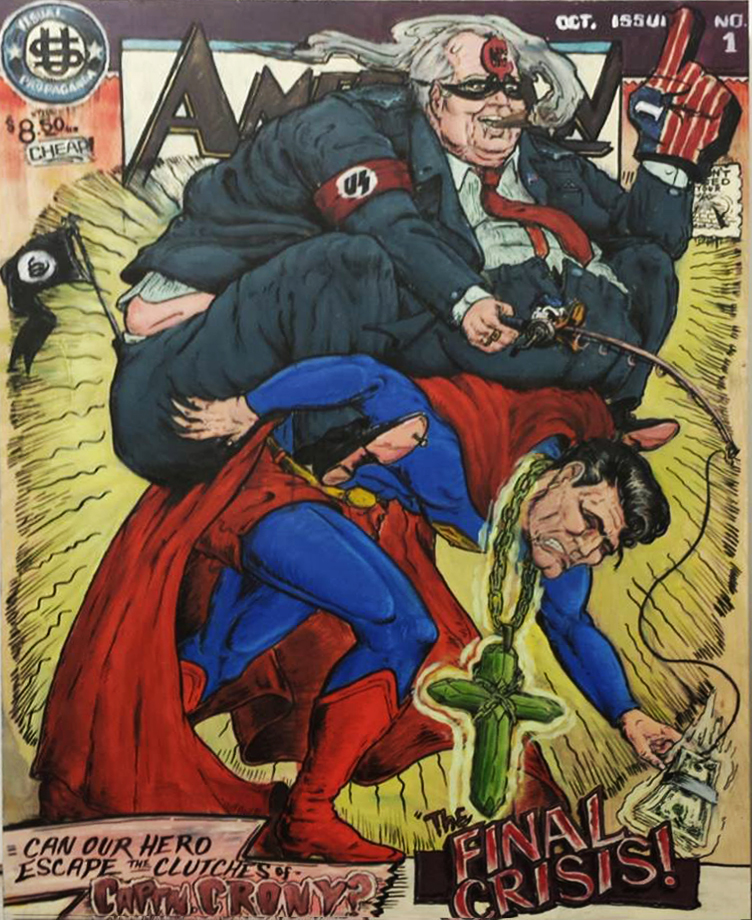The following artworks and artist statements are from Red Wedge #4; previously not posted to our site.
*** click thumbnails for larger image ***
David Mabb
The installation Long Live the New! Morris & Co. Hand Printed Wallpapers and K. Malevich’s Suprematism, Thirty Four Drawings, including covers, addendum and afterword is made from a combination of two books: a Morris & Co. wood block printed wallpaper pattern book from the 1970s containing 45 sample wallpaper designs by William Morris, the 19th Century English wallpaper, textile and book designer, poet, novelist and Communist; and the Russian artist and pioneer of abstraction Kazimir Malevich’s Suprematism, Thirty Four Drawings, published in 1920. Pages from Malevich’s book, including its front cover and afterword, have been painted (or, for the afterword, pasted) sequentially over the pages and front cover of the Morris & Co. wallpaper book. This interleaves the two designs, which are formally ‘merged’ together, ceasing to be objects that can be held and becoming an installation of paintings. But another transformation also takes place. The ‘politics of form’, the aesthetic investigation of the ideological intersections and differences of the two books, re-visions the world out of its constituent historical elements. Morris’ once utopian wallpaper designs are recharged with political meaning by their dialectical juxtaposition with Malevich’s Suprematist drawings and vice versa. This suggests a way of reinterpreting the past, through a restaging and reconfiguring of key moments in the history of art and design, that investigates what a visual language of change might look like. Long Live the New! questions both the rose tinted medievalism of Morris and Malevich’s idealised Suprematism. (David Mabb)
Richard Reilly
Working in my notebooks/journals is a daily process in the contemplation of current events, readings, and notes for tasks at hand. In my experience, mainstream news outlets, like the New York Times, often seem to have the right words, though seldom in the right order. In the process of taking in the news there are often phrases, letters, type, and headlines that grab my attention, but not for their ostensible use. These are clipped, and played with, in various arrangements until an order that more closely resembles my experience on the streets, or in conversations, or with the various studies/books I’ve been reading. (Richard Reilly)
Jon Cornell
What responsibility does art have to a surrounding community?
Is its function merely to provide onlookers with something beautiful?
Does an austere landscape embracing a snowy peaked cottage give such a respite from the cyclical drudgery of everyday life that a society can truly forget their struggles? OR should art exist as merely a spectacle of wealth? An opportunity for bourgeois socialites to compare intellects?
I would argue that this romanticized depictions of nature in works by those like Thomas Kinkade only propagates a fictional narrative of human prosperity in similar fashion to the official art of Nazi Germany, while super conceptual art is incommunicable to the general public. They aren’t reflective of the times or issues of contemporary culture and their falsehoods therefore perform a larger disservice to their audience, especially those marginalized and ultimately removed from such works.
To this end, I would suggest that art can never truly be neutral in its sociopolitical context. No matter its setting, art either works to challenge existing ideologies or social constructs, or in doing nothing, merely promotes them.
Through a study into the complex web of church and state, I describe how the American condition falters under a capitalist regime. Throughout the body of my work, I identify incongruences within pervading socio-political tropes. By dissections of religion and culture, I identify how the American people are subjugated by their own ideologies, thereby perpetuating a cycle of class struggle and social injustice. I assert that the American hero has failed in the face of material desire and his blind faith to a ruling plutocracy, and that organized religion has been ultimately subsumed by politics as a tool of control. Using the visual language of American culture against itself, I’ve created a body of works that reflect this dark underbelly of American culture.
In a culmination of this studio practice, I’ve created an installation to serve as an index of my past creations, as well as a centennial tribute to Duchamp’s Fountain. This installation attempts to challenge the authority and hierarchical structures of both the American apparatus as well as that of high art galleries, museums, and universities. The toilet and urinal serve to degrade and demean an increasingly nationalistic and intolerant populous in American culture, while the collaboration of wheat pastes and graffiti on the stalls promotes the efficacy of “low culture” and guerilla methodologies in art practice and champions art as a truly countercultural exercise. (Jon Cornell)
David Mabb is an artist who works with appropriated imagery to rethink the political implications of different aesthetic forms in modern art and design history. Recent work has focused on William Morris. Mabb’s interest in Morris stems from the social and political connotations of Morris’ work, the continued relevancy of Morris’ politics and the continuing market for Morris’ designs. Mabb’s interpretations and reconfigurations of Morris’ designs consider the relationship between Morris’ own thinking and other forms of cultural production, particularly art and design produced in Russia around the time of the Revolution. Mabb is a Reader in Art at Goldsmiths, University of London, where he is Programme Co-Director of MFA Fine Art.
Richard Reilly is a multi-media artist working primarily in photography and collage. Reilly is the principal photographer for All the Art Magazine. He was born in 19-Hunnert-and-58 in St. Louis and lives in Tower Grove. He has shown art intermittently since the mid-1980s.
Jon Cornell is an artist who lives in Saint Louis, Missouri.















